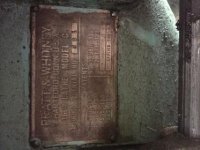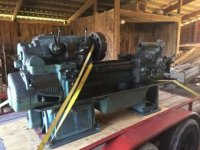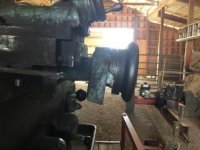jspivey
Aluminum
- Joined
- Nov 18, 2018
- Location
- Southern Illinois
Hello all,
I've been on the forum for a while but this is my first post in this sub forum, although I am a frequent reader. We recently got a new CNC lathe in the shop where I work, and the boss decided to get rid of this Pratt Model C 16x30. He basically gave it to me. Unfortunately that is where the good news ends. While the lathe was being moved it fell off of the skates and broke several handles. Combined with the fact that there is a very significant amount of wear in the ways, I find myself in an unfortunate position.
Basically, I believe that this lathe is beyond saving, and I have decided that I am going to strip everything that is worth saving and send the rest (hopefully just the casting) to the scrap yard. Before it was moved, the lathe ran very quietly and smoothly, so I believe everything in the headstock is in good shape, although I have not been inside to look. I know that when people restore older machines they often need parts that are hard find and I hope that somebody may be able to use some of the stuff that I take off/out this lathe. I love these old machines and it makes me sick to scrap anything that somebody may be able to use down the road.
Since I have no way to unload the machine from my trailer, I'm going to let it sit for the week and hopefully get it completely stripped this weekend. I will try and label all the parts and store them in an appropriate manner.
I am not trying to do this to make a huge profit or anything, I simply what to save what I can from this beautiful piece of old iron so that maybe it can find life somewhere else.
If anyone has any input on this situation, I would love to hear your thoughts. I will post a few pictures here to show the damage on the machine.

I've been on the forum for a while but this is my first post in this sub forum, although I am a frequent reader. We recently got a new CNC lathe in the shop where I work, and the boss decided to get rid of this Pratt Model C 16x30. He basically gave it to me. Unfortunately that is where the good news ends. While the lathe was being moved it fell off of the skates and broke several handles. Combined with the fact that there is a very significant amount of wear in the ways, I find myself in an unfortunate position.
Basically, I believe that this lathe is beyond saving, and I have decided that I am going to strip everything that is worth saving and send the rest (hopefully just the casting) to the scrap yard. Before it was moved, the lathe ran very quietly and smoothly, so I believe everything in the headstock is in good shape, although I have not been inside to look. I know that when people restore older machines they often need parts that are hard find and I hope that somebody may be able to use some of the stuff that I take off/out this lathe. I love these old machines and it makes me sick to scrap anything that somebody may be able to use down the road.
Since I have no way to unload the machine from my trailer, I'm going to let it sit for the week and hopefully get it completely stripped this weekend. I will try and label all the parts and store them in an appropriate manner.
I am not trying to do this to make a huge profit or anything, I simply what to save what I can from this beautiful piece of old iron so that maybe it can find life somewhere else.
If anyone has any input on this situation, I would love to hear your thoughts. I will post a few pictures here to show the damage on the machine.









